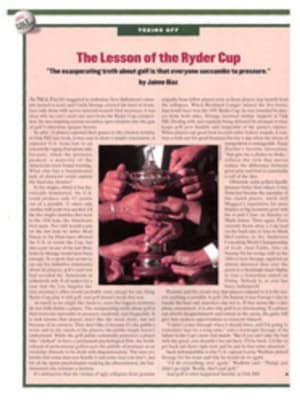
ARMED COMBAT SERIOUS BIRDERS WILL BATTLE TO THE ENDS OF THE EARTH TO BUILD UP THEIR LISTS
The Northern Lapwing is a dapper crested Eurasian shorebird that
turns up on the wrong side of the ocean every half-century or
so. When a member of the species appeared on a horse farm in
Southampton, N.Y., last winter, hundreds--no, thousands--of
people from all over the country descended on that rural corner
of Long Island: fully grown men and women who swung
state-of-the-art binoculars, spotting scopes and cameras, and
dashed up and down country lanes following the merest rumor of
the bird's location.
"Over there!" Off they galloped.
"Oops, it flew. Over there!" The mob reversed direction.
An incensed farmer appeared. "Off my pasture!" he shouted,
waving his arms and flushing the bird.
"It landed by the barn!" the cry went up, and the farmer was
nearly trampled in the ensuing stampede.
Who are these people? What makes them behave so oddly? They are
from all over the U.S., and they flew across the country or
drove for days and then elbowed aside the husbandman, pushing
their way forward in order to add the Northern Lapwing to their
(life) (world) (North American) (U.S.) (New York) (Long Island)
lists. This is power bird-watching, and it has turned a once
genteel pastime into a highly competitive sport.
In another, more innocent era, birdwatching was the eccentric
enthusiasm of silver-haired Auduboners on annuities and the
subject of wry little "Talk of the Town" items in The New
Yorker. No more. Birdwatching has turned into birding, a macho
game that requires skill, experience, time, money and passion, a
high-tech sport with the entire globe for a playing field.
There are 9,000 to 10,000 species of birds, and at least four
people have seen 7,000 of them. Close to 900 different birds can
be seen in North America, and about a dozen birders have proved
it is possible to see more than 800--no small accomplishment
when you consider that finding even 700 requires: 1) camping out
on an Alaskan island off the coast of Siberia and waiting for
Asian strays to stagger in, and 2) being ready to fly anywhere
on a moment's notice when sightings are reported.
The American Birding Association (ABA), keeper of the flame,
publishes a sort of Guinness Book of Records for birds, tracking
birding's highest achievers in a given year, state, country,
region, continent or the world. Benton Basham, who in 1983 ran
up 711 species by shuttling from his home in Chattanooga to the
Dry Tortugas, the Salton Sea and the outer Aleutians, ranks No.
1 on this continent, with 823 species. But the world's No. 1
birder is 64-year-old Phoebe Snetsinger of St. Louis, who has
seen 7,977 species. She recently stopped by her home after
forays to Gabon and Uganda. Soon she would leave for Mexico in
hopes of crossing the 8,000 line before the end of the year. Her
husband, David, describes himself as MCB--Married to a Combat
Birder.
Combat birders get tips from an international hot line or,
nowadays, the Internet. When a rare, storm-battered,
navigationally impaired Siberian Thrush wobbles out of the fog
and lands on the outer reaches of Attu Island, Alaska, it's sure
to be greeted by a phalanx of binocular-wielders who will call
it in on radio phones. Birders who "need" this thrush will drop
everything to get up there before it gets away.
If you don't need this thrush and you are working on your world,
South American and Brazilian lists, you can try northeastern
Brazil, where a single wild Spix's Macaw--an almost extinct
species--has been sighted. Everyone needs that bird; hardly
anyone has seen it in the wild except the birdcatchers who have
trapped it out for the cage bird trade. World listing is only
the main event. There are 24-hour "birdathons," a World Series
of Birding, breeding bird atlases, Christmas bird counts, big
days, big years and, of course, lists, lists, lists. The birds
in question have to be "alive, wild and unrestrained," according
to ABA rules, and they must be securely identified. "Heard
birds" are supposed to count, so that half-crazed combatants
won't destroy a bird's habitat by trying to force it into view,
but most birders count only birds they have seen. The object is
to find as many species as possible and to find rarities.
(Paradoxically, if a bird is too rare, it probably doesn't
count. Los Angeles and Miami are full of loose parrots, but
because they were imported in captivity they are no more
countable than if they were still in their cages.)
Although the ABA makes the rules and logs records, verification
is another matter. In the old days, if you wanted to get your
sighting authenticated, you had to shoot the bird and submit the
carcass to the nearest university biology department or a
museum's ornithology department. Nowadays, documentation
consists of a detailed description and photos. Most states have
semiofficial publications or committees that authenticate
rarities. Otherwise, there is the honor system.
Serious birders bend over backward not to make claims that they
cannot substantiate and historically have been more than willing
to share those they can back up. Try to one-up a hot-shot birder
("Did you see that Nimble-crested Popinjay?"), and you can
expect a snow job ("Yup. Fourteen this morning. Western
subspecies, every one. Notice the Thayer's Gull and Bicknell's
Thrush with them?"). Mr. or Ms. Hotshot will then tell you where
to locate and how to recognize these rarities, and will phone
them in to the local hotline or Rare Bird Alert so others can at
least have a cold shot. (There are now 102 Rare Bird Alerts in
42 states and the District of Columbia.)
But these holdovers from classier days may be on the verge of
extinction. In some areas competitive birders have begun to
withhold information, ostensibly to prevent rare-bird riots and
keep devil-may-care birders from damaging habitats and scaring
birds away. There may be other motives as well. When a bird
shows up on a Rare Bird Alert, there are no more insiders, only
hordes of outsiders.
The U.S. Fish & Wildlife Service estimates that in this country
there are 25 million people over the age of 16 who, in an
average year, travel more than a mile from home to see birds;
there are also said to be 65 million occasional or backyard
bird-watchers. The ABA, home of the hard-cores, has gone from
6,000 to 16,000 members in only five years.
The economic impact of those increases is substantial.
Bird-watchers collect not only numbers and rarities but also
checklists, bird books, software, birdsong CDs, CD-ROMs, film
and tape, as well as optical equipment and cameras of
ever-greater power, refinement and cost. Expenditures add up to
millions ($2 million was spent on birdseed alone in the U.S.
last year). There are now travel companies that specialize in
bird tourism, the fastest-growing and most environmentally
conscious segment of ecotourism and the best economic hope for
many beleaguered natural areas.
Combat birding is known as twitching in the United Kingdom, and
some observers consider the Brits to be the real champs at this
game, because unlike most Americans, they scorn birding tours.
True to the traditions of Empire, twitchers range the world on
their own looking for birds, often quite heedless of discomfort
and personal danger. In 1990 two twitchers were killed by
Shining Path guerrillas who doubtless had their own
interpretation about what non-Latinos with binoculars were doing
in backwoods Peru.
The current British champion, Alan Greensmith, is credited with
having started the whole twitching craze in 1969, when he birded
his way from Britain to India and back on a Lambretta scooter.
Between 1970 and 1980, he birded his way around the world with a
pack on his back, funding his trip with stints as a shepherd in
the Falkland Islands and on a Ford Motor assembly line in
Australia. His count is now 6,502, and he is No. 8 on the ABA
list.
Adherents of the Find-It-Yourself School of World Birding admit
that Snetsinger is serious and knowledgeable, and that as a
woman, she could hardly indulge in their go-it-alone approach.
But they insist that paying people to take you to rare birds is
not true competitive birding; in short, it's not sporting. If
the criterion were lowest-cost-per-bird, the backpacking,
penny-pinching Brits would win hands down.
The co-champions of do-it-yourself birding in the U.S. are the
Kaestner brothers. Baltimore-based Hank, 50, who is 20th in the
ABA rankings, is a spice buyer and travels to such places as
Sumatra and Madagascar. His 42-year-old brother, Peter, who
works for the U.S. Foreign Service and has been assigned to
Malaysia, India and New Guinea, has already achieved the
ultimate birding fantasy: finding a bird new to science. The
Cundinamarca Antpitta, or Grallaria kaestneri, bears his name.
He is the ABA's No. 3 birder, with 7,104 species; if he keeps at
it, he will be the undisputed champ.
Opening rain forests and other remote areas poses serious
environmental threats, but it lets the birders in. Thirty years
ago there was no way to get to many sites and no way to identify
the birds if one did. Now the world has shrunk, and many hot
spots are becoming dangerous or otherwise off-limits. With
habitats dwindling and species in peril or on the verge of
extinction, amateur birders have redoubled their efforts to
document the birds of the world, often well ahead of the
scientists, sometimes only a step or two ahead of the birds'
extinction.
Some of this frenzied activity does have scientific value.
Christmas bird counts, started in 1900 as an alternative to
Christmas bird pot shoots, have produced a lot of census data,
and it is possible to deduce some important trends from this
mass of information. More recently, birders have been enlisted
to help produce a series of breeding bird atlases for various
states, provinces and regions.
You don't have to go to the Brazilian rain forest or wildest
Alaska to be a bird-watcher. You don't even have to leave the
city. A Siberian Spotted Redshank has wintered in Brooklyn for
the past three years, and Peregrine Falcons now breed on
virtually every major bridge in New York City. At certain times
of the year, some of the best bird-watching in the world can be
done in urban parks. Just don't forget to take along your Cities
list.
Eric Salzman, the editor of the Linnaean Society of New York, is
5,556 species shy of Snetsinger's total.
COLOR ILLUSTRATION: MICHAEL WITTE [Drawing of bird watchers aiming cameras and binoculars at white bird]
COLOR ILLUSTRATION: MICHAEL WITTE [Drawing of woman looking at equipment-laden bird watcher]

